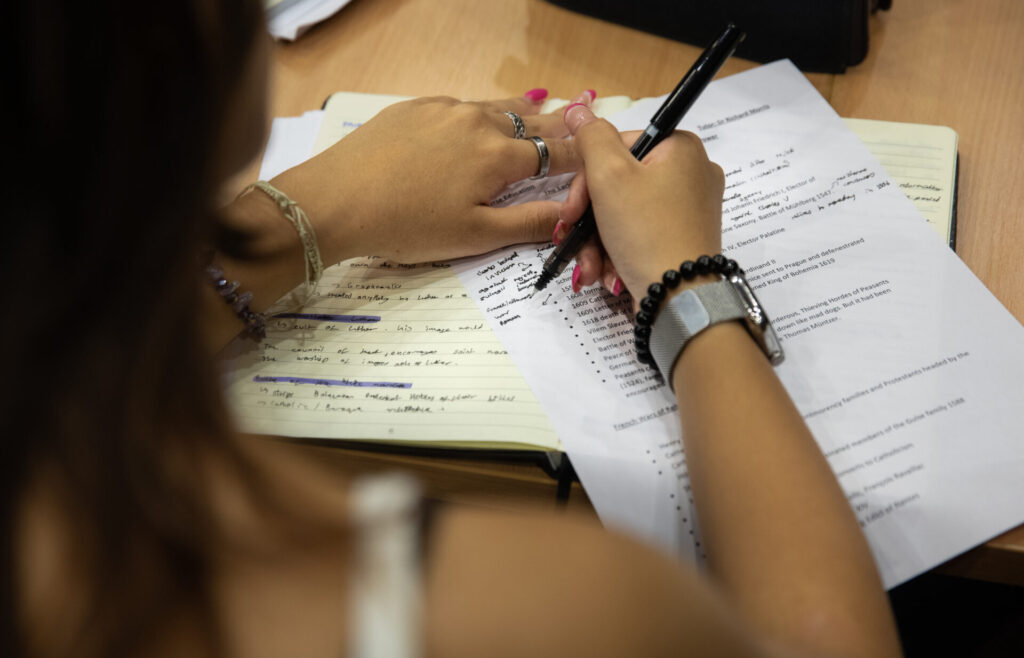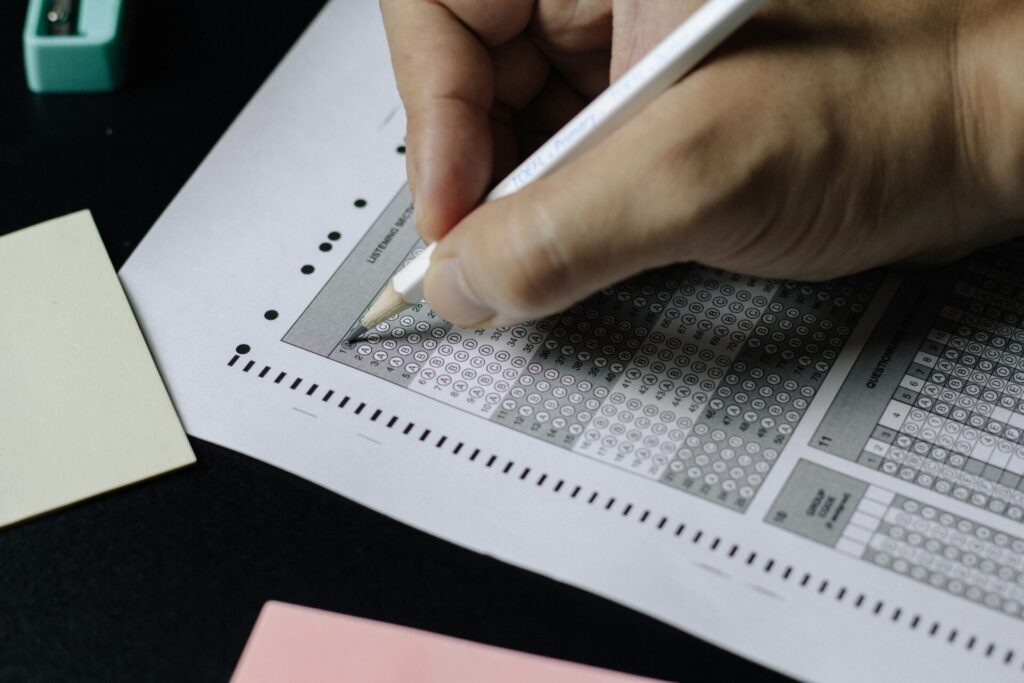Writing an essay quickly can be stressful, and delivering a quality output under such conditions requires practice, speedy writing skills, and essay writing mastery.
While practice is key, you can deliver an essay fast with a solid strategy. Activities like Immerse’s Essay Competition are an opportunity to challenge and showcase your essay writing skills under time constraints.
If you are preparing to write an important essay and want to learn how to write one quickly, today’s post will guide you through the essay process.
Let’s get started!
1. Planning is Key
Writing quality essays fast requires proper planning for structuring your thoughts and ideas. Doing this, even under tight deadlines, such as in an exam setting, can save you significant time during the essay writing process.
That said, let’s go into the details.
Understand the Essay Topic
The first step to writing an excellent essay is to understand the topic of the essay you want to write. If the assignment was given to you by your professor, don’t be afraid to ask for more explanation on any unclear part of the assignment.
Asking for clarification doesn’t mean you have no hope in writing a great essay. However, it would be a waste of time and effort to write something that doesn’t even answer the essay question because you didn’t understand it.
If you do so, it doesn’t matter how good your essay is; you’ll receive a bad grade.
If in an exam setting, take your time to read the essay question carefully, ensuring you’ve completely understood what it’s asking you to do.
Note the keywords and requirements.
For example, you could underline key instructional words in the title, such as “compare,” “argue,” or “analyse”. This forces your mind to focus on the right task, so you write the essay with this in mind.
Brainstorm Quickly
Now that you understand the essay topic and what is required of you, the next step is brainstorming. To brainstorm the topic, jot down everything that comes to mind.
Don’t worry right now whether your thoughts make sense. Your focus should be on quantity over quality. Later, you can focus on quality.
Use a timer to limit brainstorming to three to five minutes. Once the timer is up, select ideas that best fit the essay’s needs and discard any irrelevant ones.
Do Quick Research
After brainstorming, the next step is to improve your understanding of the topic by quickly gathering some general information about it through research.
This quick research will help ensure the outline you craft in the next step is informed and relevant. Without initial research, you may overlook key points or include irrelevant ones.
However, if you are in an exam setting, this tip wouldn’t apply.
Draft a Flexible Outline
Armed with some understanding of the essay topic, quickly draft an outline to help you structure your thoughts, the main ideas, and subpoints based on what you’ve learned so far.
Mapping out an outline makes it easier to start writing and helps you stay on track as you go. Your essay outline will typically be divided into three main sections:
- Introduction
- Body Paragraphs
- Conclusion
Conduct Focused Research
Once you understand the assignment and have crafted an outline, you must start researching. It helps to time this phase because spending too much time on research can lead to procrastination. “One more source” can easily turn into hours you could have spent writing the essay.
To overcome the temptation of procrastinating on research, spend no more than 30 minutes per page of the final paper. For example, if the paper is supposed to be five pages, don’t spend more than 2.5 hours on research gathering key points or quotes.
Don’t worry if you don’t have enough information. If you find that you need more information after you start writing, you can always do more research. However, as mentioned earlier, this tip does not apply if you are in an exam hall.
When searching for sources, the library, online databases, reputable websites, or academic journals are excellent places to start. Get your sources, record citation details (author, title, publisher, date, etc.), take notes to help you formulate your position and angle on the topic, and then get to writing.
You can also use tools like Zotero, EndNote, or even a simple spreadsheet to keep track of your sources. This ensures that you have everything needed to cite them later.
If you’re preparing ahead of time, Immerse’s Research Idea articles can provide inspiration and save valuable time when brainstorming and planning your essay.
Create the Perfect Writing Environment
Now that you have completed the planning phase, you may be eager to start jotting down your ideas, but before you do so, you need to create the right environment for writing.
Creating the right setting will free you of distractions, allowing you to give a zen-like focus to the writing. If you fail to do so, you open yourself up to distractions, which will cause you to lose concentration and procrastinate when writing essays.
To create the best writing environment, here are some best practices:
- Go to a quiet place such as a library, an off-campus coffee shop, or wherever you know that people won’t interrupt you.
- Use a comfortable chair and table. Don’t write while in bed; you may easily fall asleep.
- Block digital distractions. If you need the Internet to write, you can install an app that blocks distracting sites.
- Assemble all your writing supplies.
- If you don’t find it distracting, then you can use music that will get you in the writing flow mode.
However, if you are in an exam setting where you may have less control, you can limit distractions. Here are some things you can do:
- Arrange your desk neatly, with only essential materials in place.
- Keep your phone away.
- Use noise-cancelling earplugs, if allowed, to reduce auditory distractions.
Focus on Quality Over Quantity
Remember, during the brainstorming phase, we said your focus should be on quantity over quality. But now that you are about to get into the writing mode, it is time to focus on quality over quantity.
For example, If the essay is supposed to have a final page count of six to eight, you may be tempted to write a paper that’s eight or even nine pages. After all, more is better, right?
Wrong!
A good six-page paper is far better than an okay eight-page essay. Frankly, some topics can be less than eight pages, and six is more than enough. If you try to stretch it out, you may dilute your argument.
2. Writing Efficiently
Now that your plan is in place and you have created the perfect writing environment, it’s time to turn your outline into a well-crafted essay. Focus on producing a complete first draft without worrying too much about perfection.
Here is how to write efficiently:
Write a Strong Introduction
The essay introduction sets the tone. Hook your reader with a catchy opening sentence that grabs their interest and informs them of what to expect. You can begin with an interesting question, a surprising fact, or a bold statement emphasising the topic’s relevance.
- Example Hook: Writing about the invention of the printing press? You could begin with: “The invention of the printing press revolutionised human communication, marking the dawn of widespread knowledge and transforming society forever.”
Provide Background on Your Topic
Follow your hook by providing background information that will aid the reader in understanding your position. This could entail defining complex vocabulary, summarising significant scholarly works or discussions on the subject, or briefly explaining the topic’s historical significance. Avoid excessive detail here—save that for the essay’s main body.
Present the Thesis Statement
The next step is to develop your thesis statement. Your thesis statement is the primary argument of your essay. It should be clear, concise, and directly express your position on the topic. It is typically one or two sentences long.
Map the Structure
In longer essays, you can conclude the introduction by quickly explaining the topics discussed in each section of the essay. This takes the reader through your structure and provides a preview of how your argument will develop.
For instance: “This essay will first explore the technical advancements that enabled the printing press, followed by its immediate impacts on literacy and communication, and finally, its long-term influence on social and cultural transformation.”
Pro tip: The introduction typically makes up 10–20% of your essay, depending on its length.
Writing the Main Body
The body of your essay is where you present and develop your arguments, supporting your thesis with evidence and analysis. Its purpose is to present, interpret, and analyse the information and sources you have gathered to support your argument.
Here is what you should know:
Length of the Body Text
The body often accounts for 60–80% of the essay. This could be just three paragraphs for a short high-school essay, whereas, for a graduate school essay of 5,000-word count, the body could take up 8–10 pages.
Paragraph Structure
To give your essay a clear structure, organise it into paragraphs; each paragraph should focus on one key idea contributing to your argument. Use the following structure for clarity:
- Topic Sentence: Start each paragraph with a sentence summarising its main idea. It should connect to the thesis and transition smoothly from the previous paragraph.
- Evidence: After the topic sentence, support your point with relevant data, examples, or quotes from credible sources and immediately add in-text citations. This saves time during editing and ensures you remember to credit a source.
- In-depth Analysis: Explain and present evidence, showing how it supports your argument.
Pro tip: Use transition words like however, additionally, or consequently to create clear connections between the sentences.
Writing the Conclusion
The conclusion is the last section of the essay. It should typically take up no more than 10–15% of the text. A strong essay conclusion…
- Recaps your thesis
- Ties together your main points
- Shows why your argument matters
A great conclusion should finish with a memorable sentence that leaves the reader with a strong final impression. Avoid the following mistakes to make your essay’s conclusion compelling:
- Including new arguments or evidence
- Undermining your argument
- Using concluding phrases like “To sum up…” or “In conclusion…”
3. Editing Under Pressure
Once you’ve finished writing your draft, use the remaining time to refine your work.
To efficiently edit your essay:
- Review your essay’s overall structure.
- Pay close attention to the thesis statement and main sentences.
- Check whether your arguments are clear and well-supported.
- Check to see if all the information within each paragraph flows logically to the next and aligns with your thesis.
- Replace overly complex phrases with concise alternatives.
- Ensure you don’t have any lexical, contextual, grammar, or punctuation issues or typos.
- Use tools like Grammarly to help you quickly identify errors. Always review suggestions critically to maintain your essay’s tone and intent.
- Cross-check your in-text citations to ensure each is included in the bibliography.
- Ensure your citations consistently follow the required style guide throughout the essay (e.g., MLA, APA, or Chicago style).
That’s it! Your essay is now ready.
Need personalised guidance from industry experts and university mentors? Explore resources available on our Succeed platform.
4. Reviewing Your Essay with Fresh Eyes
Once you are done editing, having someone else review your work can be helpful. This is because you are naturally blind to mistakes in your own writing.
When it comes to finding a fresh eye to help you with this phase, you have a few options:
- Get a reliable friend to read the paper.
- Take the paper to your college’s writing centre.
- Ask your professor for feedback. This is only sometimes possible, but your professor may be willing to provide input before you turn in the work, mainly if it is a term paper or capstone project. Professors frequently incorporate this input into assignments by assigning separate due dates for proposals, drafts, and final versions. Even if they do not, it is never a bad idea to solicit comments. The worst they can say is “no.”
- Lastly, imagine you are about to present your essay to a group of professors and read your essay aloud. Reading out your paper lets you catch the errors yourself.
That said, it’s not always possible to let someone look over your work – for example, in an exam setting. In that scenario, you can plan to take a final look towards the end of the time limit.
Join the Immerse Education 2025 Essay Competition
Follow the instructions to write and submit your best essay for a chance to be awarded a 100% scholarship.

Bonus Tips for Essay Writing Success
Here are some bonus tips to streamline your process when writing under pressure or honing your craft for future success:
Write the Conclusion and Introduction Last
One of the most significant barriers to writing an essay or even a blog post is writing the introduction. Hence, it may be smart to leave the introduction until you’ve finished the essay’s main body.
It may sound counterintuitive, but this tactic can be helpful, especially if you have to churn out the essay on a deadline.
An added advantage to this approach is that it can help you avoid writing an essay with an introduction that doesn’t fit the final draft. The same goes for the conclusion.
Practice Makes Perfect
Our final tip for you is to practice. As you know, perfection requires consistent practice. To work on your craft, you can take advantage of opportunities to refine it by checking out Immerse’s social channels.
Need more tips on how to write essays faster? Read our article: How To Write an Academic Essay: 9 Amazing Tips.
Conclusion
Writing a complex essay paper is a lot of work. However, with consistent practice and following the process discussed in this article, you’ll be able to master the skill of delivering essays quickly without losing quality.
Want to challenge yourself? Check out Immerse’s Essay Competition for a chance to showcase your writing skills and win exciting prizes.
Need more inspiration for your next essay? Explore our Research Idea articles for a wealth of potential topics for brainstorming and structuring ideas.


























